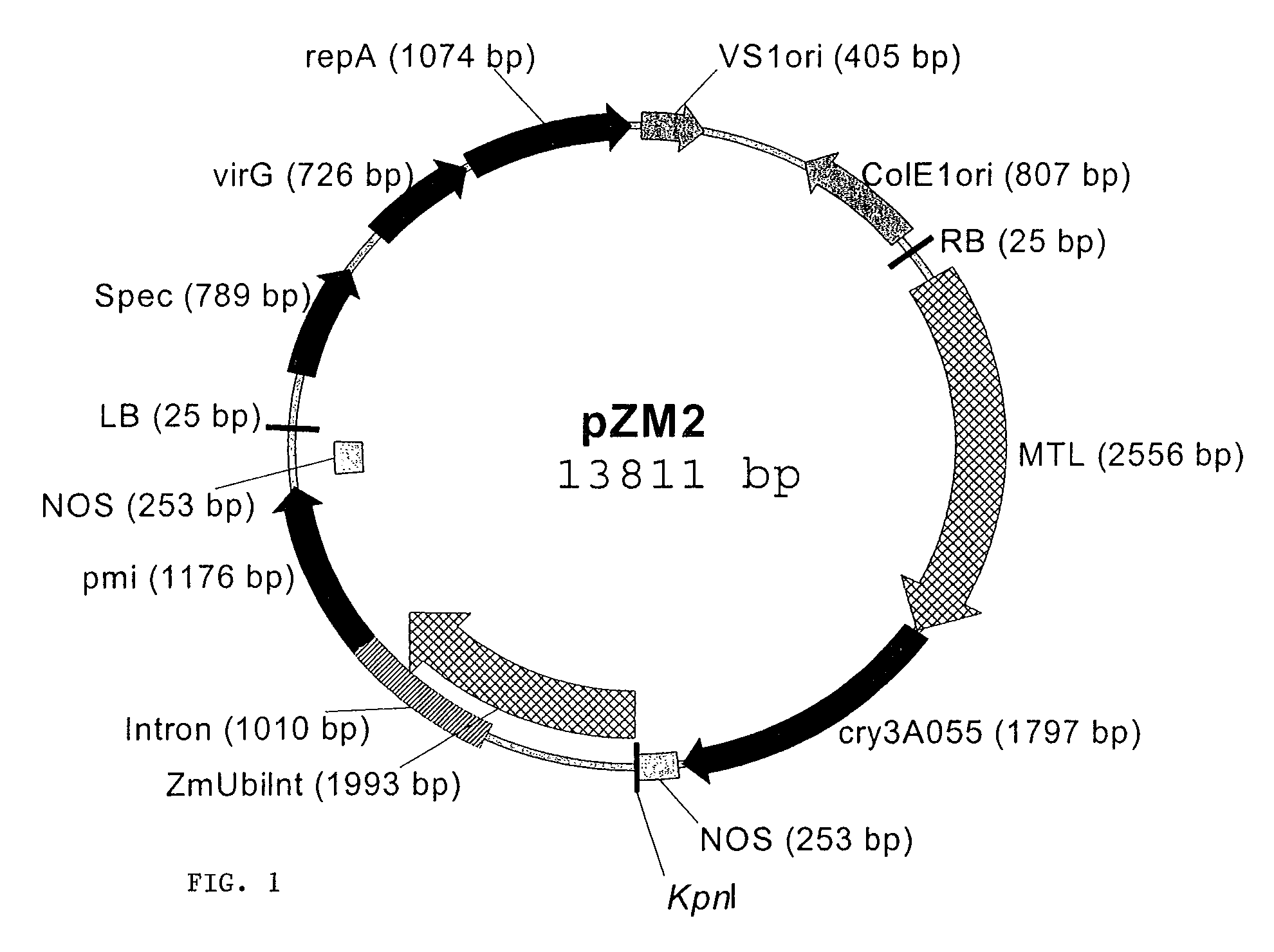Corn event MIR604
a technology of corn and mir604, applied in the field of insect resistance transgenic corn plants, can solve the problems of loss of the world's important agricultural crops, the appearance of resistant insect varieties, and the inability to discriminate methods
- Summary
- Abstract
- Description
- Claims
- Application Information
AI Technical Summary
Benefits of technology
Problems solved by technology
Method used
Image
Examples
example 1
Transformation and Selection of the MIR604 Event
[0098]The MIR604 event was produced by Agrobacterium-mediated transformation of the inbred corn (Zea mays) line A188. Type-I embryogenic callus was transformed essentially as described in Negrotto et al. (Plant Cell Reports 19: 798-803, 2000), incorporated herein by reference, using a DNA fragment from plasmid pZM26 (FIG. 1). pZM26 contains a nucleotide sequence comprising tandem expression cassettes. The first expression cassette is comprised of a MTL promoter sequence (U.S. Pat. No. 6,018,099) operably linked to a cry3A055 coding sequence further operably linked to a nopaline synthase 3′ end transcription termination and polyadenylation sequence. The second expression cassette is comprised of a maize ubiquitin promoter (ZmUbiInt) (Christensen et al. 1992 PMB 18: 675) operably linked to a pmi coding sequence further operably linked to a nopaline synthase 3′ end transcription termination and polyadenylation sequence.
[0099]Immature embr...
example 2
MIR604 Detection by TAQMAN PCR
[0102]TAQMAN analysis was essentially carried out as described in Ingham et al. (Biotechniques, 31:132-140, 2001) herein incorporated by reference. Briefly, genomic DNA was isolated from leaves of transgenic and non-transgenic corn plants using the Puregene® Genomic DNA Extraction kit (Gentra Systems, Minneapolis, Minn.) essentially according to the manufacturer's instruction, except all steps were conducted in 1.2 ml 96-well plates. The dried DNA pellet was resuspended in TE buffer (10 Mm Tris-HCl, pH 8.0, 1 mM EDTA).
[0103]TAQMAN PCR reactions were carried out in 96-well plates. For the endogenous corn gene control, primers and probes were designed specific to the Zea mays alcohol dehydrogenase (adh) gene (Genbank accession no. AF044295). It will be recognized by the skilled person that other corn genes can be used as endogenous controls. Reactions were multiplexed to simultaneously amplify cry3A055 and adh or pmi and adh. For each sample, a master mix...
example 3
MIR604 Detection by Southern Blot
[0107]Genomic DNA used for southern analysis was isolated from pooled leaf tissue of ten plants representing the backcross six (BC6) generation of MIR604 using essentially the method of Thomas et al. (Theor. Appl. Genet. 86:173-180, 1993), incorporated herein by reference. All plants used for DNA isolation were individually analyzed using TAQMAN PCR (as described in Example 2) to confirm the presence of a single copy of the cry3A055 gene and the pmi gene. For the negative segregant controls, DNA was isolated from pooled leaf tissue of five plants representing the BC4 generation of event MIR604. These negative segregant plants were individually analyzed using TAQMAN PCR and the assays were negative for the presence of the cry3A055 gene and the pmi gene, but were, as expected, positive for the assay internal control, the endogenous maize adh gene.
[0108]Southern analysis was carried out using conventional molecular biology techniques. Genomic DNA (7.5 μ...
PUM
| Property | Measurement | Unit |
|---|---|---|
| Tm | aaaaa | aaaaa |
| temperature | aaaaa | aaaaa |
| pH | aaaaa | aaaaa |
Abstract
Description
Claims
Application Information
 Login to View More
Login to View More - R&D
- Intellectual Property
- Life Sciences
- Materials
- Tech Scout
- Unparalleled Data Quality
- Higher Quality Content
- 60% Fewer Hallucinations
Browse by: Latest US Patents, China's latest patents, Technical Efficacy Thesaurus, Application Domain, Technology Topic, Popular Technical Reports.
© 2025 PatSnap. All rights reserved.Legal|Privacy policy|Modern Slavery Act Transparency Statement|Sitemap|About US| Contact US: help@patsnap.com


